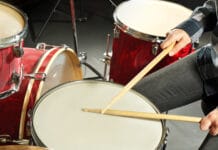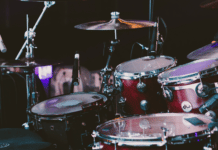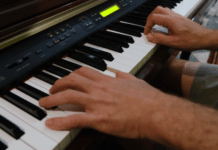I wrote a book a couple years ago (Music Practice Coach), designed to help musicians better organize their practice. Since then, I’ve had the opportunity to work with countless musicians and music teachers and have seen these principles at work. In this article, I’ll cover one of the most fundamental aspects of progressing as a musician, goal setting. I firmly believe that knowing where you are going and having a systematic approach to getting there is an essential first step in every musician’s’ journey.
Whether you’re a music teacher wishing to use S.M.A.R.T. goals for your students or a student trying to improve the quality of your practice sessions, I hope the S.M.A.R.T. goals in this article can help you.
Why Do You Need Goals?
There’s an old saying that goes, “Any direction is the right direction if you don’t know where you are going.” Having a clear sense of what areas of your musicianship you wish to improve is a fundamental first step in the direction of getting there. The desire to get better in and of itself is too vague and too overwhelming. Get better at what? In comparison to what? For what reason? Clearly defined goals can be turned into daily actions and habits which lead to the progress we desire.
Why Use S.M.A.R.T goals?
S.M.A.R.T. goals have been used in the business world for decades. They are a process for generating actionable goals which lead in a specific direction. The intent is to take the vagueness and guesswork out of goal-setting and point to actionable steps for achieving them. Today we’re going to look at how to apply S.M.A.R.T. goals to the music world.
What Is a S.M.A.R.T. goal?
There are a number of versions of this process. For the purposes of this article, I describe S.M.A.R.T. goals as goals which are Specific and Measurable, require Actions and Resources and occur over a specific period of Time.
Now, let’s examine each step more closely. I will point out the important words in each phrase. I’ll show you the WRONG way, the RIGHT way. Your first attempts at doing this could take some time. That’s okay.
The important thing is to JUST KEEP DOING IT! It will get easier every time and pretty soon you’ll be able to recognize the steps right away.
S – Specific
In order to be useful, your goal must be as SPECIFIC as possible. Define EXACTLY what you will do.
WRONG WAY:
I will learn to do those scale thingys.
NOT SPECIFIC and thingy’s not technically a real word.
RIGHT WAY:
I will learn to play all TWELVE MAJOR SCALES in TWO OCTAVES by MEMORY in EIGHTH NOTES at a metronome marking of 100 BEATS PER MINUTE.
This is SPECIFIC.
M – Measurable
Your SPECIFIC goal should also be MEASURABLE. It must be easy to know if the goal was met. You did it or you didn’t. What is the measurement? There is no “Uh, sort of.”
WRONG WAY:
I will kind of sort of play my scales for my teacher well enough so that they don’t yell at me or quit and go sell real estate.
This is SPECIFIC but not MEASURABLE, unless you want your teacher to quit and sell real estate.
RIGHT WAY:
I will learn to play all twelve major scales FOR MY TEACHER in two octaves by memory in eighth notes at a metronome marking of 100 beats per minute WITH NO MISTAKES.
SPECIFIC and MEASURABLE.
A – Actions
Now that you have a SPECIFIC, MEASURABLE goal, it’s time to pick the ACTIONS you will use to accomplish it.
WRONG WAY:
I will play all twelve major scales for my teacher in two octaves by memory in eighth notes at a metronome marking of 100 by, um, doing stuff.
SPECIFIC and MEASURABLE, but the ACTIONS are too vague. And you say “um” too much.
RIGHT WAY:
I will play all twelve major scales for my teacher in two octaves by memory in eighth notes at a metronome marking of 100 by using SLOW PRACTICE, FINGER PATTERNS, and RECORDING THEM.
SPECIFIC and MEASURABLE, with ACTIONS
R – Resources
ACTIONS rely on RESOURCES. In the above example, slow practice is made easier through the use of a metronome. Resources can be physical, like a metronome, or personal, like a teacher. They even include such things as time and a place to practice.
WRONG WAY:
I will play all twelve major scales for my teacher in two octaves by memory in eighth notes at a metronome marking of 100 by using slow practice, finger patterns, and recording them. I will use my invisible friend Harold. He will tell me what notes to play.
SPECIFIC and MEASURABLE, with ACTIONS but if you have an invisible friend, maybe you should close this book and go play duets with them on the planet Drignut
RIGHT WAY:
I will play all twelve major scales for my teacher in two octaves by memory in eighth notes at a metronome marking of 100 by using slow practice, finger patterns, and recording them. I will use my METRONOME, SCALE SHEET, FINGERING CHART, RECORDER and PENCIL.
SPECIFIC and MEASURABLE, with ACTIONS and RESOURCES
T – Time
TIME is the final piece of the puzzle. In order for the goal to be met, it needs a due date. When will you have your scales ready? Bear in mind it may take some practice to set usable time limits. Sometimes we set a date that is too soon or too far into the future. Don’t worry if you get this wrong at first. Just keep adjusting until you find what works.
WRONG WAY:
I will play all twelve major scales for your teacher in two octaves by memory in eighth notes at a metronome marking of 100 by using slow practice, finger patterns, and playing the scales for my teacher. I will use my metronome, scale sheet, fingering chart, recorder, pencil and teacher to achieve this goal before I turn 92.
SPECIFIC and MEASURABLE, with ACTIONS and RESOURCES. However, unless you are currently 91, you may want to look for a shorter period of time.
RIGHT WAY:
I will play all twelve major scales for my teacher in two octaves by memory in eighth notes at a metronome marking of 100 by using slow practice, finger patterns, and playing the scales for my teacher. I will use my metronome, scale sheet, fingering chart, recorder, pencil and teacher to achieve this goal BY THE END OF THE SEMESTER.
SPECIFIC and MEASURABLE, with ACTIONS and RESOURCES in a reasonable amount of TIME.
Review
Now that we’ve explored each step, let’s go back and look at our original “goal”:
I will learn to do those scale thingys.
Here it is again, showing how it breaks down, according to the S.M.A.R.T. steps:
I will play all twelve major scales for my teacher in two octaves by memory in eighth notes at a metronome marking of 100 by using slow practice, finger patterns, and playing the scales for my teacher. I will use my metronome, scale sheet, fingering chart, recorder, pencil and teacher to achieve this goal by the end of the semester.
Which one will be easier to achieve?
Evaluating Your Progress and Updating Your Goals
Periodically, you’ll want to stop and take a snapshot of your progress and compare it to your original plan. Are you still on track? Is the goal still relevant? Was your approach too aggressive? Not aggressive enough? Be honest and realistic with yourself. If you are struggling, how could you tweak one or more of the steps to help get you back on track? Do your goals need to be updated? Modified? Have they been accomplished? What do you want to tackle next?
I hope this structure helps you get where you want to go! It is systematic, flexible and can be used by musicians of any level and in any area of music-making. Take some time TODAY to figure out some areas of your playing that you have been neglecting and that could use a S.M.A.R.T. approach!
For more tips on practicing, check out these tips.
Table of Contents






